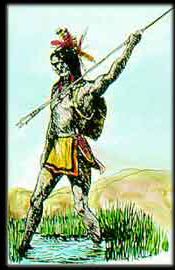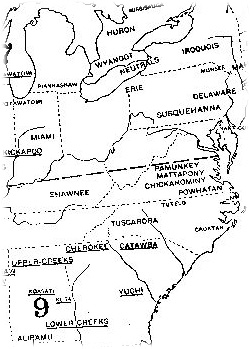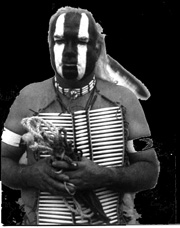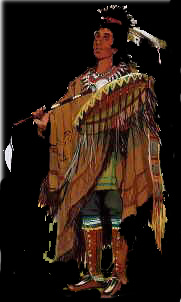
The Shawnees
and Their Place in Settlement Pennsylvania History.
aThis
Page is Part of The Subject
Heading: Native
Tribes of Southeastern and Southcentral Pa [See
Subject
Heading Table of Contents]
aaThis
Subject
Heading is part of The Chapter EntitledPennsylvania
& Our Pennsylvanians
[See Pa
Chapter
Index]
aaaThe
Chapter
is found in Our
American Immigrants, a section of the Within
The Vines Website [See General
WT
Vines Site Map]
Within The
Vines Home * *
Copyright & Terms
of Use
* *
Email Webmistress
The
Shawnee in Pennsylvania History [also known as the Savannah , Shawano,
and Cumberland Indians ]
The Shawnees were
an important Algonquian-speaking tribe who came to Pennsylvania from the
west in the 1690s, some groups settling on the lower Susquehanna and others
with the Munsees near Easton. In the course of time they moved to the Wyoming
Valley and the Ohio Valley, where they joined other Shawnees who had gone
there directly. They were allies of the French in the French and Indian
War and of the British in the Revolution, being almost constantly at war
with settlers for forty years preceding the Treaty of Greenville in 1795.
After Wayne's victory at Fallen Timbers (1794), they settled near the Delawares
in Indiana, and their descendants now live in Oklahoma. The Shawnee History
in Pennsylvania is closely associated with both the Iroquois
of the Iroquois League and the Lenape / Delaware
Indians, both with dedicated pages in this site.
Abstract of Page
Contents:
The Shawnee
of the Ohio Valley were forced south by the Iroquois
during the Beaver Wars in early contact history. They then sought
refuge and lived near the Cherokee in America's south. But the Seneca
of the Iroquois Confederacy pursued them there, conquered them, and
the Shawnee were forced to migrate again, many going to live with
their traditional grandfathers the Lenape/Delaware
of eastern Pennsylvania who then shared their condition of subjugation
to the
Iroquois on contact with William
Penn in 1682. As a result , they shared with the Lenape/Delaware the tragedy
of the Walking Purchase
in 1738, another migration west, and a subsequent hatred for the Pennsylvania
colonists from their new homes in the Ohio Valley of the French . This
hatred was expressed by the ferocious Shawnee and Delaware attacks on the
Pennsylvania frontier during the French and Indian War .
 a a |
Page
Contents:
|
| |
| aaa |
| aaa |
| aaaa |
aaa |
|
Click on Images shown throughout this page for Image
Source Details
|
| |
|
|
The
Shawnee Background
The Shawnee are
mentioned as being both western and eastern in branches. These were an
Algonquian speaking people often associated with the Carolinas. In 1660,
as a result of the Beaver wars, and owing to the might of the Iroquois
Confederacy, they were forced south from their
ancestral pre contact regions, to the locale with which
they are traditionally associated and far removed from their ancestral
grandfathers : The Lenape or Delaware people. The Shawnee of South
Carolina included the Piqua and Hathawekela divisions of the tribe but
the Shawnee were pursued to the south by the Seneca of the Iroquois Confederacy,
and more migration of their peoples was the result. The Piqua thus
appear in the earliest European settlement of Lancaster County, Pennsylvania,
but the Shawnee importance to our study is not limited to Lancaster County.
As a result of the Seneca's hostile persistence in harassing them,
the Shawnee migrated north in subjugation to the Iroquois Confederacy,
through Pennsylvania, with some of the Shawnee settling IN
Pennsylvania beside the ancestral grandfathers, the Lenape, likewise
dominated by the Iroquois Confederacy. The period of the migration north
from the Carolinas corresponds with the Iroquois domination of the Natives
of Pennsylvania, and is part of the reason that the Iroquois sent a diplomat
of their people to Pennsylvania to assure the contact of the migrating
indians to the Susquehanna Valley. {see the
Iroquois Chief of the Susquehanna Valley}
The "western Shawnee
are mentioned about the year 1672 as being harassed by the Iroquois, and
also as allies and neighbors of the Andaste,
or Conestoga [ed note, AKA Susquehannocks] , who were themselves
at war with the Iroquois. As the Andaste
were
then incorrectly supposed to live on the upper waters of the Ohio river,
the Shawnee would naturally be considered their neighbors. The two tribes
were probably in alliance against the Iroquois, as we find that when the
first body of Shawnee removed from South Carolina to Pennsylvania, about
1678, they settled adjoining the Conestoga
,
and when another part of the same tribe desired to remove to the Delaware
[editor's note: the Delaware Native Nation] in 1694 permission was granted
on condition that they make peace with the Iroquois. Again, in 1684, the
Iroquois justified their attacks on the Miami by asserting that the latter
had invited the Satanas (Shawnee) into their country to make war upon the
Iroquois. This is the first historic mention of the Shawnee -- evidently
the western division -- in the country N. of the Ohio river" Text
From Shawnee'
entry In Hodge's Handbook
|
 |
|
Click on Image for Source Details
|
Useful Links:
Shawnee'
entry from Hodge's Handbook
Abstract: The 'Shawnee' entry from Handbook of American Indians North
of Mexico, edited by Frederick
Webb Hodge (Smithsonian Institution, Bureau of American Ethnology Bulletin
30. GPO: 1910.)
|
|
|
 |
|
Click on Image for Source Details
|
Useful Links:
Shawnee'
entry from Hodge's Handbook
Abstract: The 'Shawnee' entry from Handbook of American Indians North
of Mexico, edited by Frederick
Webb Hodge (Smithsonian Institution, Bureau of American Ethnology Bulletin
30. GPO: 1910.) |
" |
Shawnee
Appearance in Pennsylvania
There is no proof that
these people had a part in Penn's first treaty in 1682. The Shawnee
seem to have first appeared in eastern Penna. in 1677 or 1678, due to native
warfare forcing their migration. In 1694, by invitation of the Delaware's
and their allies, another large party came from the South and settled with
the Munsee on the Delaware, the main body
fixing themselves at the mouth of the Lehigh river, near present Easton,
Pa., while some went as far down as the Schuylkill. As a result of the
subjugation of the Delaware by the Iroquois, the Shawnee also migrated
west, corresponding with the removal of the Delaware. Pequea in now Lancaster
County was their town. The Pequea Valley and its native inhabitants
figures in importance in the early history of our
Mennonites of Lancaster County, Penna., where they are described and
mentioned.. In addition,
Andrew Shriber's early experience in now southern Adams County seems
to indicate Shawnee presence in that region, as comment on the Catawba
with whom the Shawnee warred are mentioned.
aaaa
"In October 1736,
during a treaty council outside Philadelphia at Stenton, Pennsylvania [editor's
note,: Stenton is the home of our
ancestor James Logan whose home often featured for negotiations]
, the Seneca chief Kanickhungo, representing the Six Nations, explained
to the proprietor Thomas Penn that, soon after his father William Penn
'came into this Country, he and we treated together.' 'He opened and cleared
the Road between this Place and our Nations, which was very much to our
good Liking, and it gave us great Pleasure. We now desire that this Road,
for the mutual Accommodation and Conveniency of you and us, who travel
therein to see each other, may be kept clear and open, free from all Stops
or Incumbrances.' In a few words, the Iroquois leader invoked a simple
element of the landscape, ' the Road,' as a metaphor for communication,
diplomacy, and cultural exchange between Indians and whites. Yet the road
also referred to a physical space, a passage that connected national territories,
communities, and people, a space used by many parties. Experience had taught
Kanickhungo that shared roads often suffered from 'Stops or Incumbrances'ólike
brambles, competition for resources and political power stood in the way
of cooperation. He thus invoked the memory of the first colonial peacemaker
who had advocated tolerance toward native peoples, and he gently reprimanded
the son for his apparent deficiencies. Kanickhungo, like many eighteenth
century Americans, tried to articulate ways that coexistence could work.
As representative of one imperial power addressing another, he drew on
metaphors that implored native Americans and Euramericans to be equally
responsible for keeping the route between their communities clear, to share
that frontier as they negotiated a better understanding.[1] " 30:sample
chapter of At
the Crossroads Indians and Empires on a Mid-Atlantic Frontier, 1700-1763
by
Jane T. Merritt
|
The
Known History of the Shawnee from Pre Contact to Present
The
migration to South Carolina of the Shawnee as a result of the post contact
Beaver Wars and the Strength of the Iroquoian Iroquois Confederacy
The Shawnee were
Algonquian speakers like their "grandfathers" the
Lenni Lenape [AKA Delaware] , and are mentioned by name in the Walam
Olum [or Wallam Olum] of the Lenape people; It appears from that source
that they migrated with the Delaware and were present by a great
inland lake thought to be Lake Erie by 1500. Theirs was a patrilineal
culture present in Ohio, West Virginia, and western Pennsylvania19
[southern Ohio and northern Kentucky18] disrupted
by the Iroquoian speaking Iroquois
Confederacy who, in 1656, having conquered and assimilated
their Iroquian-speaking rivals except the
Susquehannock, started to clear the Algonquin tribes from the Ohio
Valley and lower Michigan19. In 1660
the Shawnee were forced to flee the Ohio Valley during the first part of
the Beaver Wars (1630-1700) 19. Bands of
Shawnee scaterred from " the Gulf Coast to the Delaware valley in western
New Jersey. Some went south, occupying parts of Georgia and South Carolina,
where they assisted the English in their wars against the Westos. Others
fled first to Illinois, then Pennsylvania and Maryland, settling near their
' grandfathers,' the Delawares" 18.
About
those Shawnee Who Went South
Those among the Shawnee
who went south gained approval by the Cherokee to settle in South
Carolina , thereby offering a buffer for the Cherokee against the
Catawba with whom the Cherokee warred, and setting an obvious stage
for the subsequent war between the Shawnee and the Catawba19.
At the same time, the Seneca tribe of the
Iroquois Confederacy continued to harass and attack the Shawnee escaped
to the south, bringing in a dangerous element for all, including the Cherokee
and white settlers , of the region; The Iroquois were sometimes
accompanied by the Lenape [AKA Delaware]
in their war parties, the 5 Nations [later 6] having gained
dominance over the Lenape [previously
subjugated by the Susquehannock
] . |
 Click on Image for Source Details
Click on Image for Source Details |
Why
the Recently migrated Southern Shawnee went North to the Land of Their
Ancestral Grandfathers
In 1707 a final
Catawba victory over the Shawnee forced another scattering of the
Shawnee. "Some of the Hathawekela [editor's note: The Shawnee
of South Carolina included the Piqua and Hathawekela divisions of
the tribe 29] went north to Pennsylvania
in 1706 and joined the Shawnee who were already part of the Iroquois covenant
chain. Others found refuge with the Creek in Alabama settling first on
the Chattahoochee and later the Tallapoosa. The rest joined their relatives
in Tennessee"
19.Those of the Carolina Shawnees
who went north to Pennsylvania found paradoxical refuge among the
Delaware
and Iroquois.
19
"
 Image Source
Details
Image Source
Details
|
"The first Shawnee
seem to have removed from South Carolina in 1677 or 1678, when, according
to Drake, about 70 families established themselves on the Susquehanna adjoining
the Conestoga in Lancaster co., Pa., at the mouth of the Pequea cr. Their
village was called Pequea, a form of Piqua. The Assiwikales (Hathawekela)
were a part of the later migration. ... The chief of Pequea was Wapatha,
or Opessah, who made a treaty with Penn at Philadelphia in 1701, and more
than 50 years afterward the Shawnee, then in Ohio, still preserved a copy
of this treaty. There is no proof that they had a part in Penn's first
treaty in 1682. In 1694, by invitation of the Delaware
and their allies, another large party came from the S. -- probably from
Carolina -- and settled with the Munsee on the
Delaware, the main body fixing themselves at the mouth of Lehigh r., near
the present Easton, Pa., while some went as far down as the Schuylkill.
This party is said to have numbered about 700, and they were several months
on the journey. Permission to settle on the Delaware was granted by the
Colonial government on condition of their making peace with the Iroquois,
who then received them as 'brothers,' while the Delawares acknowledged
them as their ' second sons,' i. e. grandsons. The Shawnee to-day refer
to the Delawares as their grandfathers.
From. this it is evident that the Shawnee were never conquered by the Iroquois,
and, in fact, we find the western band a few years previously assisting
the Miami against the latter. As the Iroquois,
however, had conquered the lands of the Conestoga
and Delawares, on which the Shawnee settled,
the former still claimed the prior right of domain. Another large part
of the Shawnee probably left |
South Carolina about
1707, as appears from a statement made by Evans in that year (Day, Penn,
391,1843), which shows that they were then hard pressed in the S. He says:
"During our abode at Pequehan [Pequea] several of the Shaonois Indians
from ye southward came to settle here, and were admitted so to do by Opessah,
with the governor's consent, at the same time an Indian, from a Shaonois
town near Carolina came in and gave an account that four hundred and fifty
of the flat-headed Indians [Catawba] had besieged them, and that in all
probability the same was taken. Bezallion informed the governor that the
Shaonois of Carolina -- he was told -- had killed several Christians;
whereupon the government of that province raised the said flat-headed Indians,
and joined some Christians to them, besieged and have taken, as it is thought,
the said Shaonois town." Those who escaped probably fled to the N. and
joined their kindred in Pennsylvania. In 1708 Gov. Johnson, of South Carolina,
reported the "Savannahs" on Savannah r. as occupying 3 villages and numbering
about 150 men (Johnson in Rivers, S. C., 236, 1856). In 1715 the
"Savanos" still in Carolina were reported to live 150 m. N. W. of Charleston,
and still to occupy 3 villages, but with only 233 inhabitants in all. The
Yuchi and Yemasee were also then in the same neighborhood (Barnwell, 1715,
in Rivers, Hist. S. C., 94, 1874). "29
William
Penn's Documentation of Shawnee People in Pennsylvania
aaa
At the time of Penn's
arrival 1782, he encountered Shawnee and Delaware
near present day Philadelphia and he documented the Shawnee in 1702
at a settlement "being not above 30 Cabanes [cabins] at the most
on the mouth of Pequea Creek in Penna. î [The Pequea is in now Lancaster
County and The Piqua Shawnee likely some of
the Indians as Marie Werrebaur described them , along with the
Delaware
known there , relevant to our Mennonite forebears who were
the first settlers of what is now Lancaster County . In addition, as the
Shawnee battled with the Catawba, it is likely it is the Shawnee who are
described
by Shriver, an early settler of York, now Southern Adams County, Pa,
passing frequently to use the spring on their family's land ].
"The Piqua (Pekowi, Pequa) river in now Lancaster County and
the valley with which it is associated owe their name [Pequa]
to one of the 5 subnations of the Shawnee people. By 1725 most of
the southern bands had rejoined their kinsmen in Pennsylvania and Maryland,
but pressure from the expanding white frontier and from the
Iroquois slowly pushed the Shawnees westward, where they established
new villages in the Wyoming and Susquehanna valleys."
18
This region itself
would soon feel strenuous crowding. |
 |
The
Removal of the Shawnee from Eastern Pennsylvania
"In 1737 Pennsylvania
cheated the Delaware out of their last
lands in the Lehigh Valley. The loss forced the Shawnee to also leave the
area. They settled for a time with the Munsee
and other Delaware on Iroquois lands in the Wyoming and Susquehanna Valleys,
but the crowded conditions soon had them looking at western Pennsylvania.
Except for the Wyandot, who the Iroquois were trying to lure away from
the French alliance, and a few groups of Mingo
(Iroquois descended from Huron, Neutrals, and Erie adopted during the 1650s),
no tribe had occupied the area since the onset of the Beaver Wars. Small
hunting camps on the upper Ohio were soon followed by permanent Shawnee
villages, and the Mingo not only did not object
to this, but even settled with them in the same villages. Encouraged, the
Shawnee invited
the Delaware to join them,
and during the
1740s, thousands
of Delaware and Shawnee left Iroquois domination on the Susquehanna and
moved to western Pennsylvania."18
The
known Villages of the Shawnee in Pennsylvania
Among the villages
of the Shawnee or mixed nation villages of Shawnee and other tribes
in Pennsylvania [the other nations involved being mentioned when given
] were Logstown (Delaware-Mingo), Chartierstown
, Logstown (Delaware-Mingo) , Nutimy's Town (Delaware-Mahican) ,
Paxtang (Delaware) , Peixtan (Nanticoke) , Sawcunk (Delaware-Mingo)
, Sewickley (Delaware-Mingo) , Shamokin (Delaware-Iroquois-Tutelo),
Venango (Delaware-Ottawa-Seneca-Wyandot) , Will's Town , and Wyoming (Delaware-Iroquois-Mahican-Munsee-Nanticoke)
[list
annotated from Villages of
the Shawnee in Lee Sultzman's excellent native tribes pages]
 |
General
Comments on the Shawnee and Their Role in the French and Indian War Affecting
Pennsylvania's Frontier.
-
See also mention
of the Shawnee in Pennsylvania historical texts up to 1692 in the
historical entries on Shawnees of Penna
-
Tecumseh , revered among
his own people and honored by a popular naming pattern among white
Americans including Tecumseh Sherman , was a Shawnee.
-
Like the Lenape [aka
Delaware] , the Shawnee were traditional enemies of the Iroquois . T he
Delaware, were subordinated by the confederacy in 1694. The Shawnee
and the Lenni Lenape [Delaware] were the tribes affected by the
Walking Purchase, and the Shawnee migration to more westward Penna.
corresponds with the Delaware dispertion
to that region in the 1740s. "The history of the Shawnee after their
reunion on the Ohio is well known as a part of the history of the Northwest
territory, and may be dismissed with brief notice. For a period of
40 years -- from the beginning of the French and Indian war to the
treaty of Greenville in 1795 -- they were almost constantly at war with
the English or the Americans, and distinguished themselves as the most
hostile tribe in that region. "29
No comment
on the Shawnee portrayal is offered in regards to the
image at left;
The image is offered as a glimpse of white culture
portrayal
of the Shawnee APART from their substantial
historical
role. Click on image for its source detail
|
Sources for This Page Are Included in the
larger Reference Library Given for the Natives of Pennsylvania, all of
which Involve:
1. State Museum of Pennsylvania.
Brief
Summary of the 1681 Charter.
2. From York
County History Pages of York
County
Webpages.
3. Penn
and the Indians
page of site entitled " William Penn. Visionary Proprietor" by
Tuomi J. Forrest
4 Indians,
Sources, Critics by Will J. Alpern (Prudential-Bache Securities). Presented
at the 5th Cooper Seminar, James Fenimore Cooper: His Country and His Art
at the State University of New York College at Oneonta, July, 1984. ©1985
by State University of New York College at Oneonta ["may be downloaded
and reproduced for personal or instructional use, or by libraries" ] Originally
published in James Fenimore Cooper: His Country and His Art, Papers from
the 1984 Conference at State University of New York College -- Oneonta
and Cooperstown. George A. Test, editor. (pp. 25-33)
5. Kittanning-pa.com
6. SUSQUEHANNOCK
HISTORYpart of First
Nations, Issues of Conesquence pages. Lee Sultzman
7. SUSQUEHANNOCK
HISTORY, Lee Sultzman. Part
of First
Nations Histories
8.Information
on the Susquehannock Indians from Pagewise
9. Delaware
History by Lee Sultzman.. Part of First
Nations Histories
10. Where
are the Susquehannock now? part of the pages of BrokenClaw.com
12.
Native
Americans Post Contact:, from The
Mariners Museum, Newport News, Va pages
13. . Internet
School Library Media Center, Monacan
Indians page.
14. AN
AMERICAN SYNTHESIS The Sons of St. Tammany or Columbian Order . [ the
footnotes evident in the text takent from "an American Synthesis" can be
accessed at the link given in source
15. Iroquois
.
By: Joe Wagner, with references provided.
16. The
Iroquois. by Lee Sultzman. Part of First
Nations Histories
17 William
Henry Harrison and the West , part of Dr James B. Calvert's pages
at University of Denver Website.
At the time of Penn's arrival in 1682,
the Susquehannock were subservient to the Iroquois Confederacy, just as
their enemies and neighbors, the Delaware , were. The Susquehannock were
decimated by war and disease, but the Lenape remained vital.
18. Shawnee's
Reservation a detailed site on Shawnee History
19. Shawnee
History by Lee Sultzman. . Part of First
Nations Histories
20. Marjorie Hudson,
Among
the Tuscarora: The Strange and Mysterious Death of John Lawson, Gentleman,
Explorer, and Writer, North Carolina Literary Review, 1992 [transcribed
at East North Carolina Digital History Exhibits]
21. Chief
Logan: Friend, Foe or Fiction? by Ronald R. Wenning. The
Journal of the Lycoming County Historical Society, Volume XXXVII, Number
1, Fall, 1997
22. Mingo
Indians part of The Allegheny Regional Family History Society's Web
pages
23. Weiser,
Shikellamy and the Walking Purchase By Al Zagofsky
24. Conrad
Weiser from the Pennsylvania Historical and Museum Commission
25. The
Walking Purchase from Pennsylvania Historical and Museum
Commission
26. James
Logan , Mingo Indian from The American National Biography, published
by Oxford University Press under the auspices
of the American Council of Learned
Societies.
27. The
Lineage of Mother Bedford from Mother
Bedford , a website devoted primarily to the history of Old-Bedford
County, Pennsylvania during the American Revolutionary War period.
28. Year
1736. part of the webpage entitled "Ben Franklin :A Documentary
History" by J A Leo Lemay , English Department , Professor University
of Delaware, Newark, Delaware.
29. Shawnee'
entry from Hodge's Handbook Abstract: The 'Shawnee' entry from Handbook
of American Indians North of Mexico, edited by Frederick
Webb Hodge (Smithsonian Institution, Bureau of American Ethnology Bulletin
30. GPO: 1910.)
30. sample
chapter of At
the Crossroads Indians and Empires on a Mid-Atlantic Frontier, 1700-1763
by Jane T. Merritt [book content , availability
and sample chapter viewable and obtained via The
University of North Carolina Press]
31. (New Jersey) Extract from
The Indian Tribes of North America by John R. Swanton. Bureau
of American Ethnology Bulletin 145ó1953. [726 pagesóSmithsonian Institution]
(pp. 48-55). Presented in pages of
the
Northern Plains Archive Project web site.
 a
a





